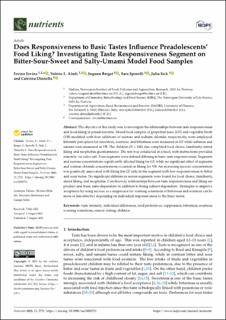Does responsiveness to basic tastes influence preadolescents’ food liking? Investigating taste responsiveness segment on bitter-sour-sweet and salty-umami model food samples
| dc.contributor.author | Ervina, Ervina | |
| dc.contributor.author | Almli, Valérie L. | |
| dc.contributor.author | Berget, Ingunn | |
| dc.contributor.author | Spinelli, Sara | |
| dc.contributor.author | Sick, Julia | |
| dc.contributor.author | Dinnella, Caterina | |
| dc.date.accessioned | 2021-09-13T11:48:00Z | |
| dc.date.available | 2021-09-13T11:48:00Z | |
| dc.date.created | 2021-09-06T16:16:05Z | |
| dc.date.issued | 2021 | |
| dc.identifier.citation | Nutrients. 2021, 13 (8), 1-22. | |
| dc.identifier.issn | 2072-6643 | |
| dc.identifier.uri | https://hdl.handle.net/11250/2775438 | |
| dc.description.abstract | The objective of this study was to investigate the relationships between taste responsiveness and food liking in preadolescents. Model food samples of grapefruit juice (GF) and vegetable broth (VB) modified with four additions of sucrose and sodium chloride, respectively, were employed. Intensity perception for sweetness, sourness, and bitterness were measured in GF while saltiness and umami were measured in VB. The children (N = 148) also completed food choice, familiarity, stated liking and neophobia questionnaires. The test was conducted at school, with instructions provided remotely via video call. Four segments were defined differing in basic taste responsiveness. Segments and sucrose concentrations significantly affected liking for GF, while no significant effect of segments and sodium chloride concentrations occurred on liking for VB. An increasing sucrose concentration was positively associated with liking for GF only in the segment with low responsiveness to bitter and sour tastes. No significant differences across segments were found for food choice, familiarity, stated liking, and neophobia. Conclusively, relationships between taste responsiveness and liking are product and basic taste-dependent in addition to being subject-dependent. Strategies to improve acceptance by using sucrose as a suppressor for warning sensations of bitterness and sourness can be more or less effective depending on individual responsiveness to the basic tastes. | |
| dc.language.iso | eng | |
| dc.subject | Bitternes | |
| dc.subject | Bitternes | |
| dc.subject | Taste intensity | |
| dc.subject | Taste intensity | |
| dc.subject | Suppression | |
| dc.subject | Suppression | |
| dc.subject | Individual Differences | |
| dc.subject | Individual Differences | |
| dc.subject | Food preferences | |
| dc.subject | Food preferences | |
| dc.title | Does responsiveness to basic tastes influence preadolescents’ food liking? Investigating taste responsiveness segment on bitter-sour-sweet and salty-umami model food samples | |
| dc.type | Peer reviewed | |
| dc.type | Journal article | |
| dc.description.version | publishedVersion | |
| dc.source.pagenumber | 1-22 | |
| dc.source.volume | 13 | |
| dc.source.journal | Nutrients | |
| dc.source.issue | 8 | |
| dc.identifier.doi | 10.3390/nu13082721 | |
| dc.identifier.cristin | 1931740 | |
| dc.relation.project | Nofima AS: 12047 | |
| dc.relation.project | EC/H2020/764985 | |
| dc.relation.project | Norges forskningsråd: 314318 | |
| dc.relation.project | Nofima AS: 202103 | |
| cristin.ispublished | true | |
| cristin.fulltext | original | |
| cristin.qualitycode | 1 |
